Analysis of Geometric Surface Structure and Surface Layer Microhardness of Ti6Al4V Titanium Alloy after Vibratory Shot Peening
Abstract
:1. Introduction
2. Materials and Methods
2.1. Tested Material
2.2. Surface Treatment before Shot Peening
2.3. Shot-Peening Process
2.4. Methodology for Measuring the Surface Structure and Surface Layer Properties
- -
- Microhardness increase ΔHV0.05;
- -
- Thickness of the hardened layer gh.
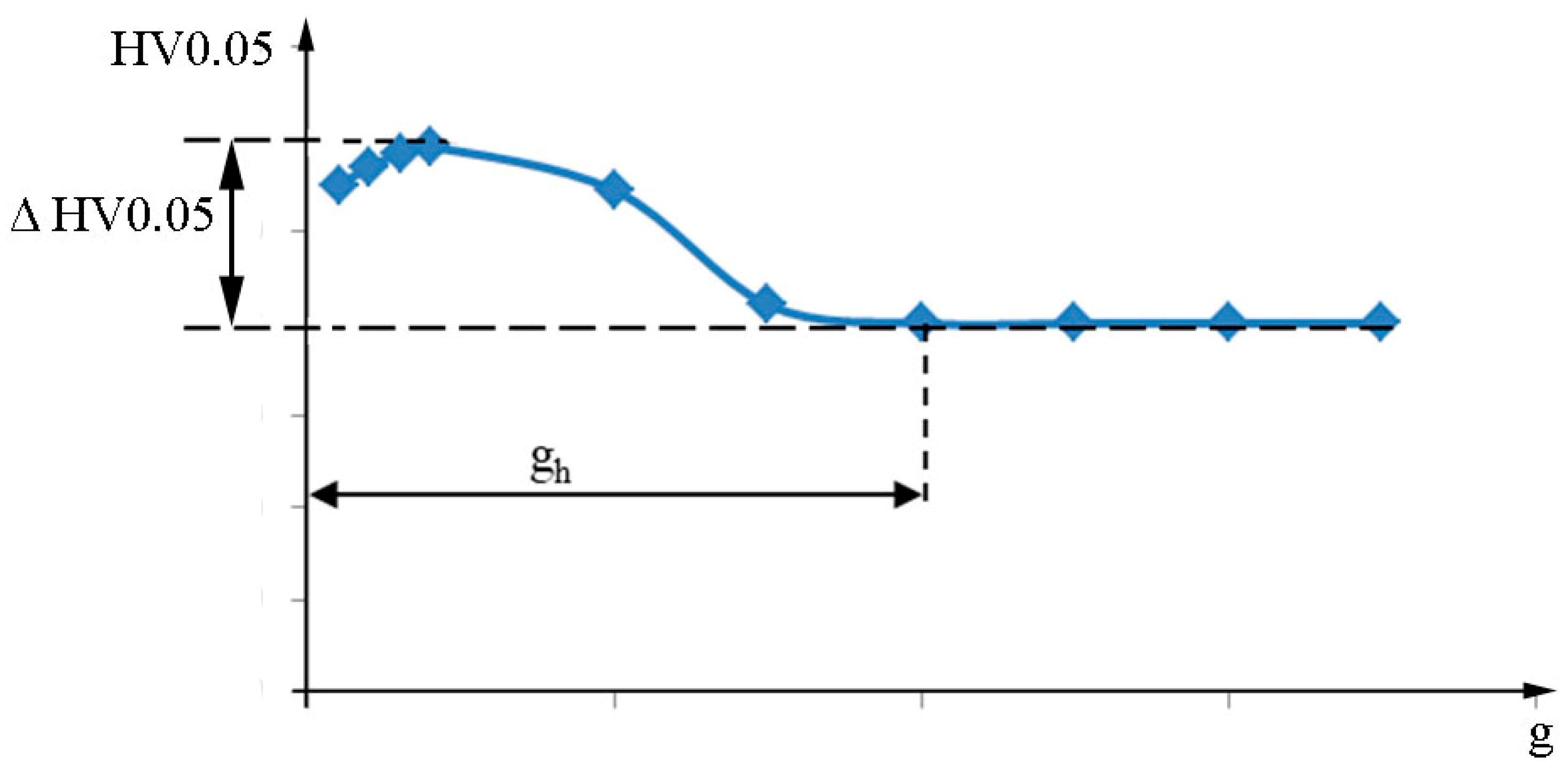
3. Results and Analysis
3.1. Surface Topography
3.2. Surface Layer Microhardness
4. Conclusions
- Vibratory shot peening leads to a reduction in roughness in the entire range of process conditions used in the experiment;
- For the value A = 33 mm and time t = 13 min, the lowest roughness value was obtained (Sa = 0.344 µm); this represents approximately a threefold reduction in the parameter compared with milling;
- The effects after the vibratory shot-peening process are correlated with the roughness after the previous machining;
- An increase in amplitude above A = 33 mm (and, consequently, the kinetic energy of impact) leads to an increase in surface roughness, which is caused by plastic deformations and the formation of protrusions as a result of the impact of shot-peening balls on the machined surface;
- The vibratory shot-peening process resulted in an increase in Smr (areal material ratio) compared with milling, enhancing the durability and wear resistance of the mating components;
- The hardened layer thickness gh after the milling process is approximately 30 μm, while the increase in microhardness is below 20 µm;
- Within the range of parameters used, an increase in amplitude and time results in an approximately linear increase in the ΔHV0.05 coefficient;
- Amplitude has a greater impact on the increase in surface layer hardening gh compared with time;
- With an increase in time, the greatest impact on changes in the surface layer hardening gh is observed until t = 13 min, but a further increase in time does not cause significant changes in the gh coefficient;
- The greatest thickness of the hardened layer, exceeding 200 µm, was obtained after burnishing with an amplitude of A = 60 mm.
Funding
Institutional Review Board Statement
Informed Consent Statement
Data Availability Statement
Conflicts of Interest
References
- Pushp, P.; Dasharath, S.M.; Arati, C. Classification and Applications of Titanium and Its Alloys. Mater. Today Proc. 2022, 54, 537–542. [Google Scholar] [CrossRef]
- Boyer, R.R. An Overview on the Use of Titanium in the Aerospace Industry. Mater. Sci. Eng. A 1996, 213, 103–114. [Google Scholar] [CrossRef]
- Gummadi, J.; Alanka, S. A Review on Titanium and Titanium Alloys with Other Metals for Biomedical Applications Prepared by Powder Metallurgy Techniques. Mater. Today Proc. 2023, 2023, S2214785323022885. [Google Scholar] [CrossRef]
- Schwartz, A.; Kossenko, A.; Zinigrad, M.; Danchuk, V.; Sobolev, A. Cleaning Strategies of Synthesized Bioactive Coatings by PEO on Ti-6Al-4V Alloys of Organic Contaminations. Materials 2023, 16, 4624. [Google Scholar] [CrossRef] [PubMed]
- Hezil, N.; Aissani, L.; Fellah, M.; Abdul Samad, M.; Obrosov, A.; Timofei, C.; Marchenko, E. Structural, and Tribological Properties of Nanostructured α + β Type Titanium Alloys for Total Hip. J. Mater. Res. Technol. 2022, 19, 3568–3578. [Google Scholar] [CrossRef]
- Fouzia, H.; Mamoun, F.; Naouel, H.; Linda, A.; Goussem, M.; Said, M.; Mohammed, A.S.; Alex, M.; Iost, A.; Weiß, S.; et al. The Effect of Milling Time on the Microstructure and Mechanical Properties of Ti-6Al-4Fe Alloys. Mater. Today Commun. 2021, 27, 102428. [Google Scholar] [CrossRef]
- Batista, M.; Morales, A.; Gómez-Parra, A.; Salguero, J.; Puerta, F.J.; Marcos, M. 3D-FEM Based Methodology for Analysing Contour Milling Processes of Ti Alloys. Procedia Eng. 2015, 132, 1136–1143. [Google Scholar] [CrossRef]
- Gupta, M.K.; Niesłony, P.; Sarikaya, M.; Korkmaz, M.E.; Kuntoğlu, M.; Królczyk, G.M.; Jamil, M. Tool Wear Patterns and Their Promoting Mechanisms in Hybrid Cooling Assisted Machining of Titanium Ti-3Al-2.5V/Grade 9 Alloy. Tribol. Int. 2022, 174, 107773. [Google Scholar] [CrossRef]
- Ezugwu, E.O. Key Improvements in the Machining of Difficult-to-Cut Aerospace Superalloys. Int. J. Mach. Tools Manuf. 2005, 45, 1353–1367. [Google Scholar] [CrossRef]
- Polishetty, A.; Shunmugavel, M.; Goldberg, M.; Littlefair, G.; Singh, R.K. Cutting Force and Surface Finish Analysis of Machining Additive Manufactured Titanium Alloy Ti-6Al-4V. Procedia Manuf. 2017, 7, 284–289. [Google Scholar] [CrossRef]
- Lindvall, R.; Lenrick, F.; M’Saoubi, R.; Ståhl, J.-E.; Bushlya, V. Performance and Wear Mechanisms of Uncoated Cemented Carbide Cutting Tools in Ti6Al4V Machining. Wear 2021, 477, 203824. [Google Scholar] [CrossRef]
- Kuczmaszewski, J.; Zaleski, K.; Matuszak, J.; Pałka, T.; Mądry, J. Studies on the Effect of Mill Microstructure upon Tool Life during Slot Milling of Ti6Al4V Alloy Parts. Eksploat. Niezawodn. Maint. Reliab. 2017, 19, 590–596. [Google Scholar] [CrossRef]
- Samborski, S.; Józwik, J.; Skoczylas, J.; Kłonica, M. Adaptation of Fracture Mechanics Methods for Quality Assessment of Tungsten Carbide Cutting Inserts. Materials 2021, 14, 3441. [Google Scholar] [CrossRef]
- Kurpiel, S.; Zagórski, K.; Cieślik, J.; Skrzypkowski, K. Investigation of Selected Surface Topography Parameters and Deformation during Milling of Vertical Thin-Walled Structures from Titanium Alloy Ti6Al4V. Materials 2023, 16, 3182. [Google Scholar] [CrossRef] [PubMed]
- Kuczmaszewski, J.; Zaleski, K.; Matuszak, J.; Mądry, J. Testing Geometric Precision and Surface Roughness of Titanium Alloy Thin-Walled Elements Processed with Milling. In Advances in Manufacturing II; Diering, M., Wieczorowski, M., Brown, C.A., Eds.; Lecture Notes in Mechanical Engineering; Springer International Publishing: Cham, Switzerland, 2019; pp. 95–106. ISBN 978-3-030-18681-4. [Google Scholar]
- Doluk, E.; Rudawska, A. Effect of Machining Settings and Tool Geometry on Surface Quality After Machining of Al/CFRP Sandwich Structures. Adv. Sci. Technol. Res. J. 2022, 16, 22–33. [Google Scholar] [CrossRef] [PubMed]
- Ciecieląg, K.; Zaleski, K. Milling of Three Types of Thin-Walled Elements Made of Polymer Composite and Titanium and Aluminum Alloys Used in the Aviation Industry. Materials 2022, 15, 5949. [Google Scholar] [CrossRef]
- Kowalik, M.; Trzepieciński, T.; Kukiełka, L.; Paszta, P.; Maciąg, P.; Legutko, S. Experimental and Numerical Analysis of the Depth of the Strengthened Layer on Shafts Resulting from Roller Burnishing with Roller Braking Moment. Materials 2021, 14, 5844. [Google Scholar] [CrossRef]
- Skoczylas, A. Influence of Centrifugal Shot Peening Parameters on the Impact Force and Surface Roughness of EN-AW 2024 Aluminum Alloy Elements. Adv. Sci. Technol. Res. J. 2021, 15, 71–78. [Google Scholar] [CrossRef]
- Matuszak, J.; Zaleski, K.; Skoczylas, A.; Ciecieląg, K.; Kęcik, K. Influence of Semi-Random and Regular Shot Peening on Selected Surface Layer Properties of Aluminum Alloy. Materials 2021, 14, 7920. [Google Scholar] [CrossRef]
- Yang, Z.; Zheng, J.; Zhan, K.; Jiang, C.; Ji, V. Surface Characteristic and Wear Resistance of S960 High-Strength Steel after Shot Peening Combing with Ultrasonic Sprayed Graphene Oxide Coating. J. Mater. Res. Technol. 2022, 18, 978–989. [Google Scholar] [CrossRef]
- Kalisz, J.; Żak, K.; Wojciechowski, S.; Gupta, M.K.; Krolczyk, G.M. Technological and Tribological Aspects of Milling-Burnishing Process of Complex Surfaces. Tribol. Int. 2021, 155, 106770. [Google Scholar] [CrossRef]
- Korzynski, M.; Dudek, K.; Korzynska, K. Effect of Slide Diamond Burnishing on the Surface Layer of Valve Stems and the Durability of the Stem-Graphite Seal Friction Pair. Appl. Sci. 2023, 13, 6392. [Google Scholar] [CrossRef]
- Walczak, M.; Szala, M.; Okuniewski, W. Assessment of Corrosion Resistance and Hardness of Shot Peened X5CrNi18-10 Steel. Materials 2022, 15, 9000. [Google Scholar] [CrossRef] [PubMed]
- Chodór, J.; Kukiełka, L.; Chomka, G.; Bohdal, Ł.; Patyk, R.; Kowalik, M.; Trzepieciński, T.; Radchenko, A.M. Using the FEM Method in the Prediction of Stress and Deformation in the Processing Zone of an Elastic/Visco-Plastic Material during Diamond Sliding Burnishing. Appl. Sci. 2023, 13, 1963. [Google Scholar] [CrossRef]
- Xie, B.; Gao, K. Research Progress of Surface Treatment Technologies on Titanium Alloys: A Mini Review. Coatings 2023, 13, 1486. [Google Scholar] [CrossRef]
- Nieslony, P.; Krolczyk, G.M.; Wojciechowski, S.; Chudy, R.; Zak, K.; Maruda, R.W. Surface Quality and Topographic Inspection of Variable Compliance Part after Precise Turning. Appl. Surf. Sci. 2018, 434, 91–101. [Google Scholar] [CrossRef]
- Revankar, G.D.; Shetty, R.; Rao, S.S.; Gaitonde, V.N. Wear Resistance Enhancement of Titanium Alloy (Ti–6Al–4V) by Ball Burnishing Process. J. Mater. Res. Technol. 2017, 6, 13–32. [Google Scholar] [CrossRef]
- Maheshwari, A.S.; Gawande, R.R. Influence of Specially Designed High-Stiffness Ball Burnishing Tool on Surface Quality of Titanium Alloy. Mater. Today Proc. 2017, 4, 1405–1413. [Google Scholar] [CrossRef]
- Han, K.; Tan, L.; Yao, C.; Zhang, D.; Zhou, Z. Studies on the Surface Characteristics of Ti60 Alloy Induced by Turning Combined with Ball Burnishing. J. Manuf. Process. 2022, 76, 349–364. [Google Scholar] [CrossRef]
- Toboła, D.; Morgiel, J.; Maj, Ł. TEM Analysis of Surface Layer of Ti-6Al-4V ELI Alloy after Slide Burnishing and Low-Temperature Gas Nitriding. Appl. Surf. Sci. 2020, 515, 145942. [Google Scholar] [CrossRef]
- Zaleski, K.; Skoczylas, A. Effect of Slide Burnishing on the Surface Layer and Fatigue Life of Titanium Alloy Parts. Adv. Mater. Sci. 2019, 19, 35–45. [Google Scholar] [CrossRef]
- Liu, Y.G.; Li, M.Q.; Liu, H.J. Nanostructure and Surface Roughness in the Processed Surface Layer of Ti-6Al-4V via Shot Peening. Mater. Charact. 2017, 123, 83–90. [Google Scholar] [CrossRef]
- Ongtrakulkij, G.; Khantachawana, A.; Kajornchaiyakul, J.; Kondoh, K. Effects of the Secondary Shot in the Double Shot Peening Process on the Residual Compressive Stress Distribution of Ti–6Al–4V. Heliyon 2022, 8, e08758. [Google Scholar] [CrossRef] [PubMed]
- Yao, C.; Wu, D.; Ma, L.; Tan, L.; Zhou, Z.; Zhang, J. Surface Integrity Evolution and Fatigue Evaluation after Milling Mode, Shot-Peening and Polishing Mode for TB6 Titanium Alloy. Appl. Surf. Sci. 2016, 387, 1257–1264. [Google Scholar] [CrossRef]
- Chen, G.; Jiao, Y.; Tian, T.; Zhang, X.; Li, Z.; Zhou, W. Effect of Wet Shot Peening on Ti-6Al-4V Alloy Treated by Ceramic Beads. Trans. Nonferrous Met. Soc. China 2014, 24, 690–696. [Google Scholar] [CrossRef]
- Wang, Y.; Zhang, Y.; Song, G.; Niu, W.; Xu, Z.; Huang, C. Effect of Shot Peening on Fatigue Crack Propagation of Ti6Al4V. Mater. Today Commun. 2020, 25, 101430. [Google Scholar] [CrossRef]
- Zaleski, K. The Effect Of Shot Peening On The Fatigue Life Of Parts Made Of Titanium Alloy Ti-6Al-4V. Maint. Reliab. 2009, 4, 65–71. [Google Scholar]
- Shi, H.; Liu, D.; Pan, Y.; Zhao, W.; Zhang, X.; Ma, A.; Liu, B.; Hu, Y.; Wang, W. Effect of Shot Peening and Vibration Finishing on the Fatigue Behavior of TC17 Titanium Alloy at Room and High Temperature. Int. J. Fatigue 2021, 151, 106391. [Google Scholar] [CrossRef]
- Wang, Y.; Wang, X.; Xu, C.; Qiu, S.; Wang, K.; Tian, K.; Yu, B.; Yu, Y. Effect of Shot Peening and Nitrogen Ion Implantation on the Fatigue Behavior of TA15 Titanium Alloys. Int. J. Fatigue 2023, 172, 107649. [Google Scholar] [CrossRef]
- Aguado-Montero, S.; Navarro, C.; Vázquez, J.; Lasagni, F.; Slawik, S.; Domínguez, J. Fatigue Behaviour of PBF Additive Manufactured TI6AL4V Alloy after Shot and Laser Peening. Int. J. Fatigue 2022, 154, 106536. [Google Scholar] [CrossRef]
- Avcu, Y.Y.; Iakovakis, E.; Guney, M.; Çalım, E.; Özkılınç, A.; Abakay, E.; Sönmez, F.; Koç, F.G.; Yamanoğlu, R.; Cengiz, A.; et al. Surface and Tribological Properties of Powder Metallurgical Cp-Ti Titanium Alloy Modified by Shot Peening. Coatings 2023, 13, 89. [Google Scholar] [CrossRef]
- Yang, Q.; Zhou, W.; Niu, Z.; Zheng, X.; Wang, Q.; Fu, X.; Chen, G.; Li, Z. Effect of Different Surface Asperities and Surface Hardness Induced by Shot-Peening on the Fretting Wear Behavior of Ti-6Al-4V. Surf. Coat. Technol. 2018, 349, 1098–1106. [Google Scholar] [CrossRef]
- Zhang, X.; Liu, D. Effect of Shot Peening on Fretting Fatigue of Ti811 Alloy at Elevated Temperature. Int. J. Fatigue 2009, 31, 889–893. [Google Scholar] [CrossRef]
- Żebrowski, R.; Walczak, M.; Klepka, T.; Pasierbiewicz, K. Effect of the Shot Peening on Surface Properties of Ti-6Al-4V Alloy Produced by Means of DMLS Technology. Eksploat. Niezawodn. Maint. Reliab. 2019, 21, 46–53. [Google Scholar] [CrossRef]
- Matuszak, J.; Zaleski, K.; Zyśko, A. Investigation of the Impact of High-Speed Machining in the Milling Process of Titanium Alloy on Tool Wear, Surface Layer Properties, and Fatigue Life of the Machined Object. Materials 2023, 16, 5361. [Google Scholar] [CrossRef]




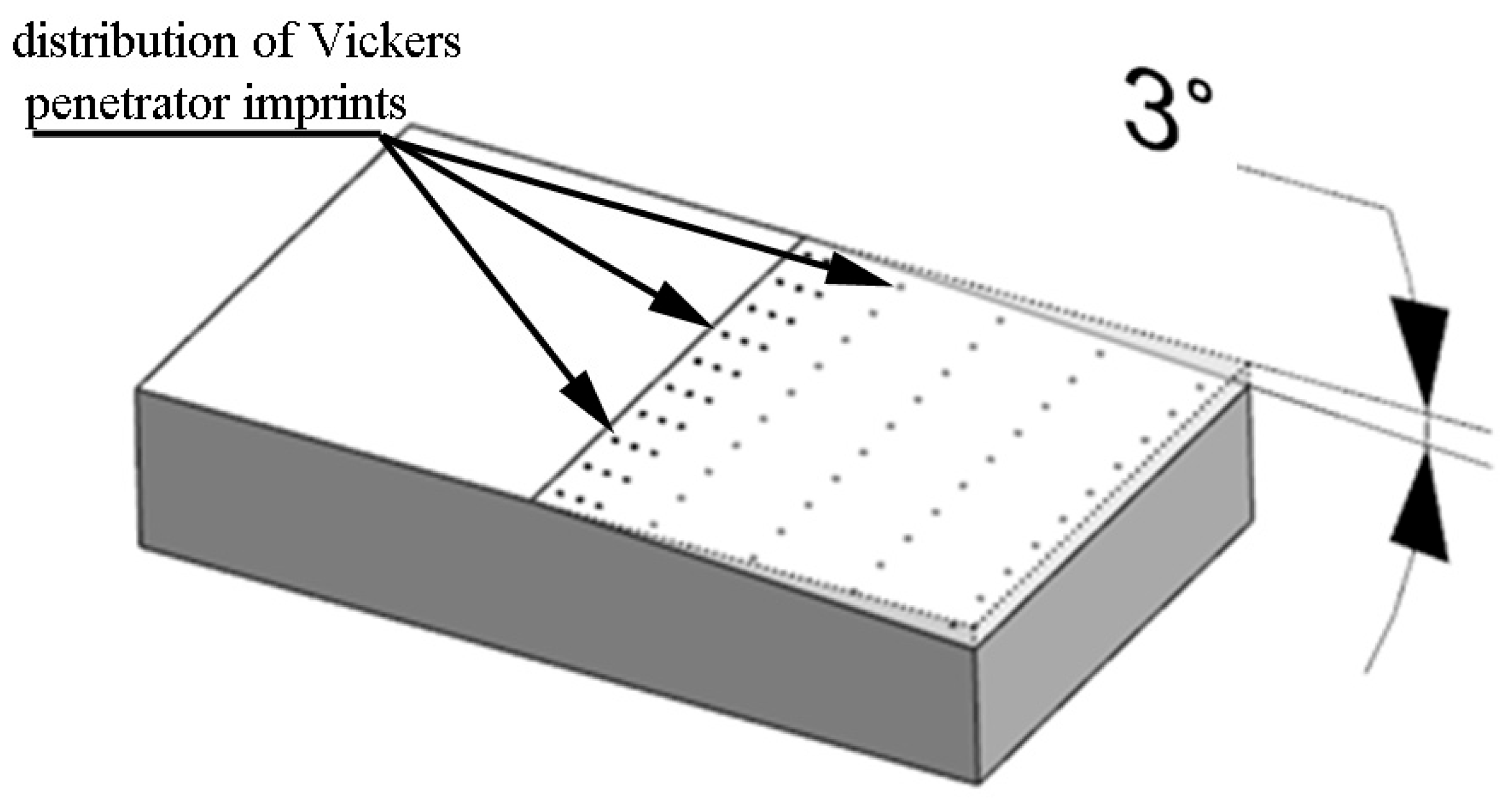

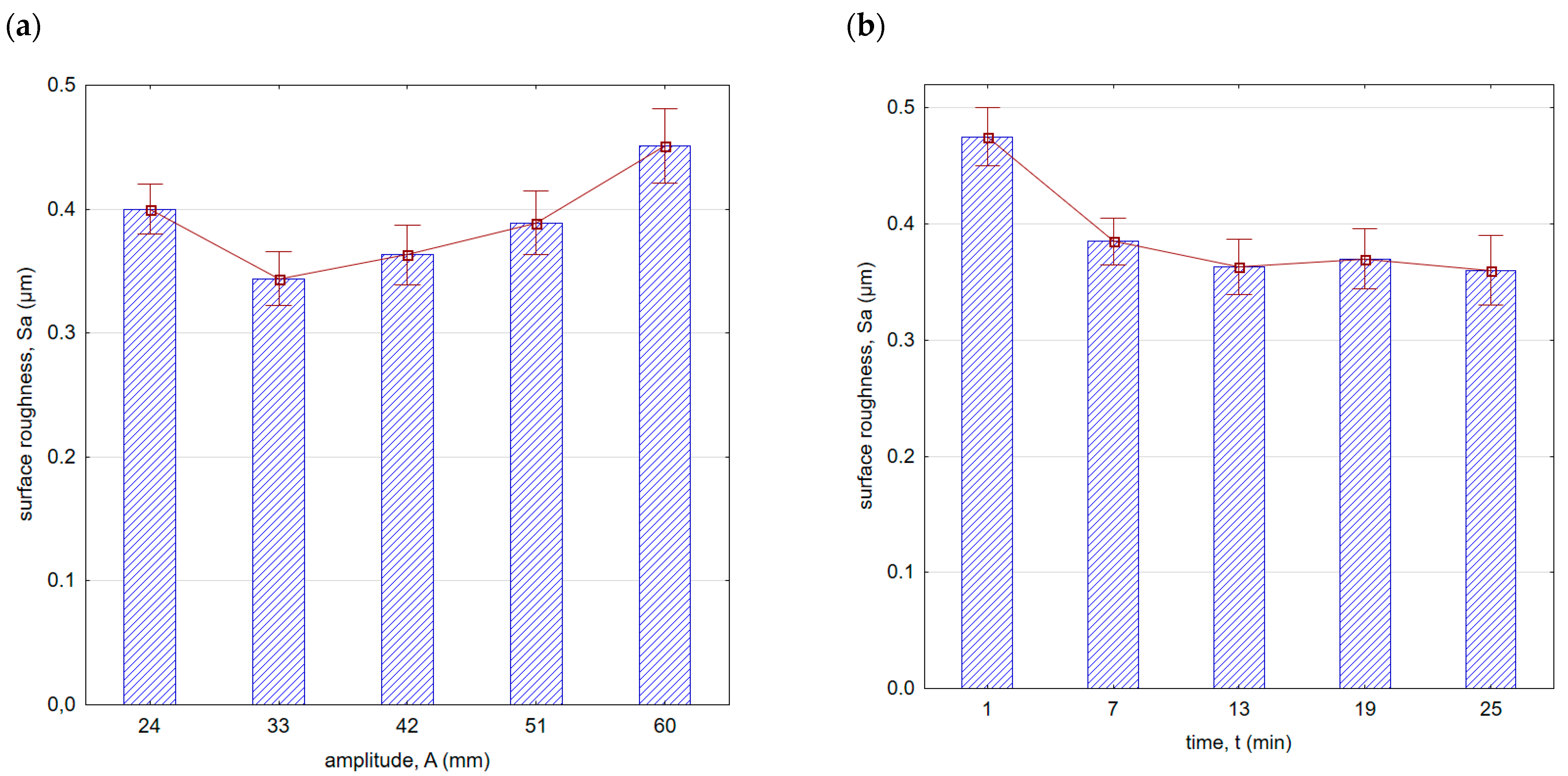
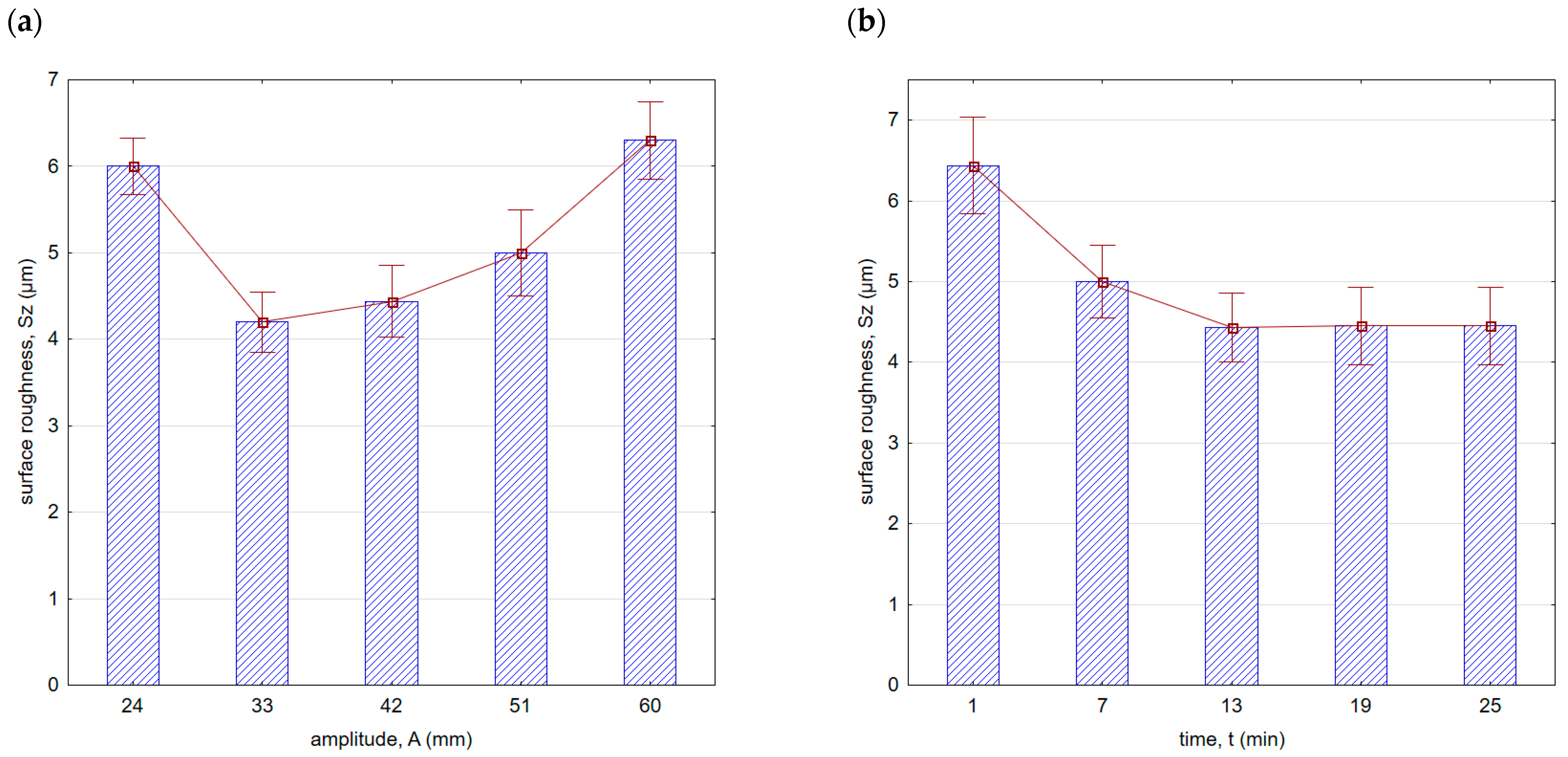
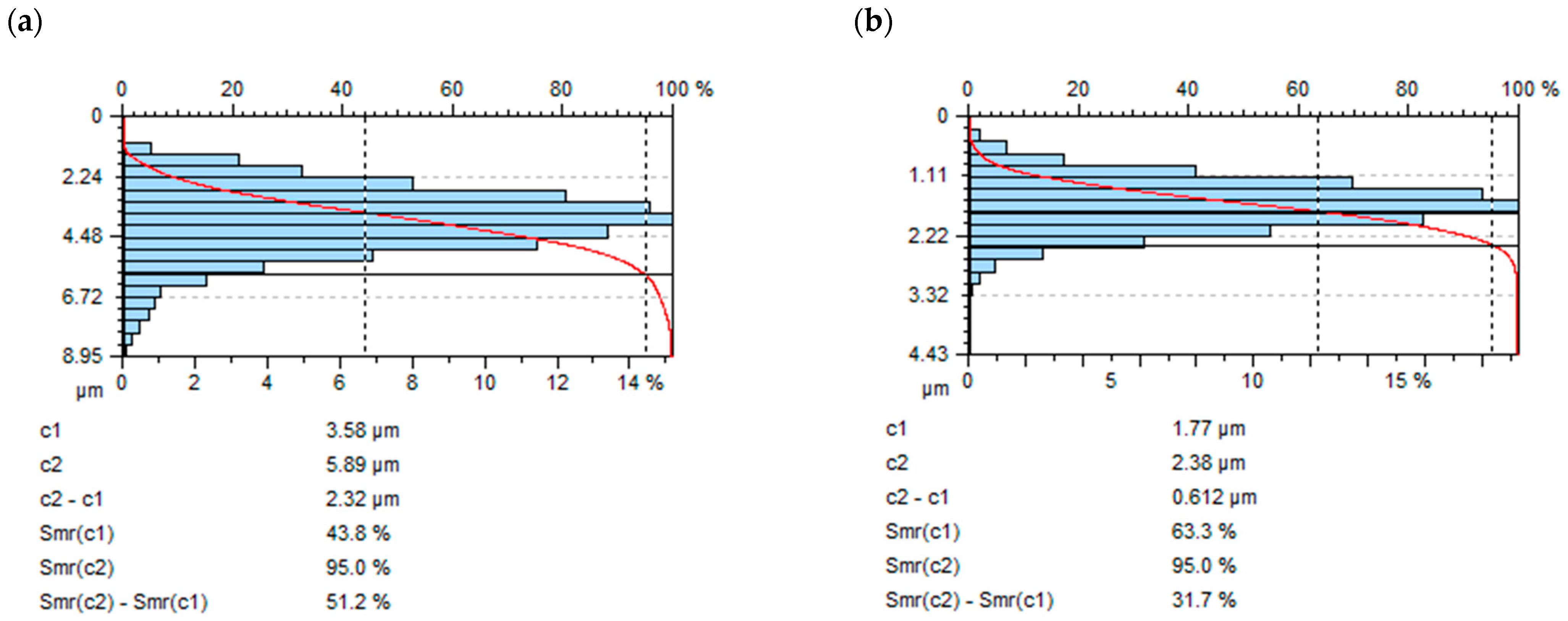
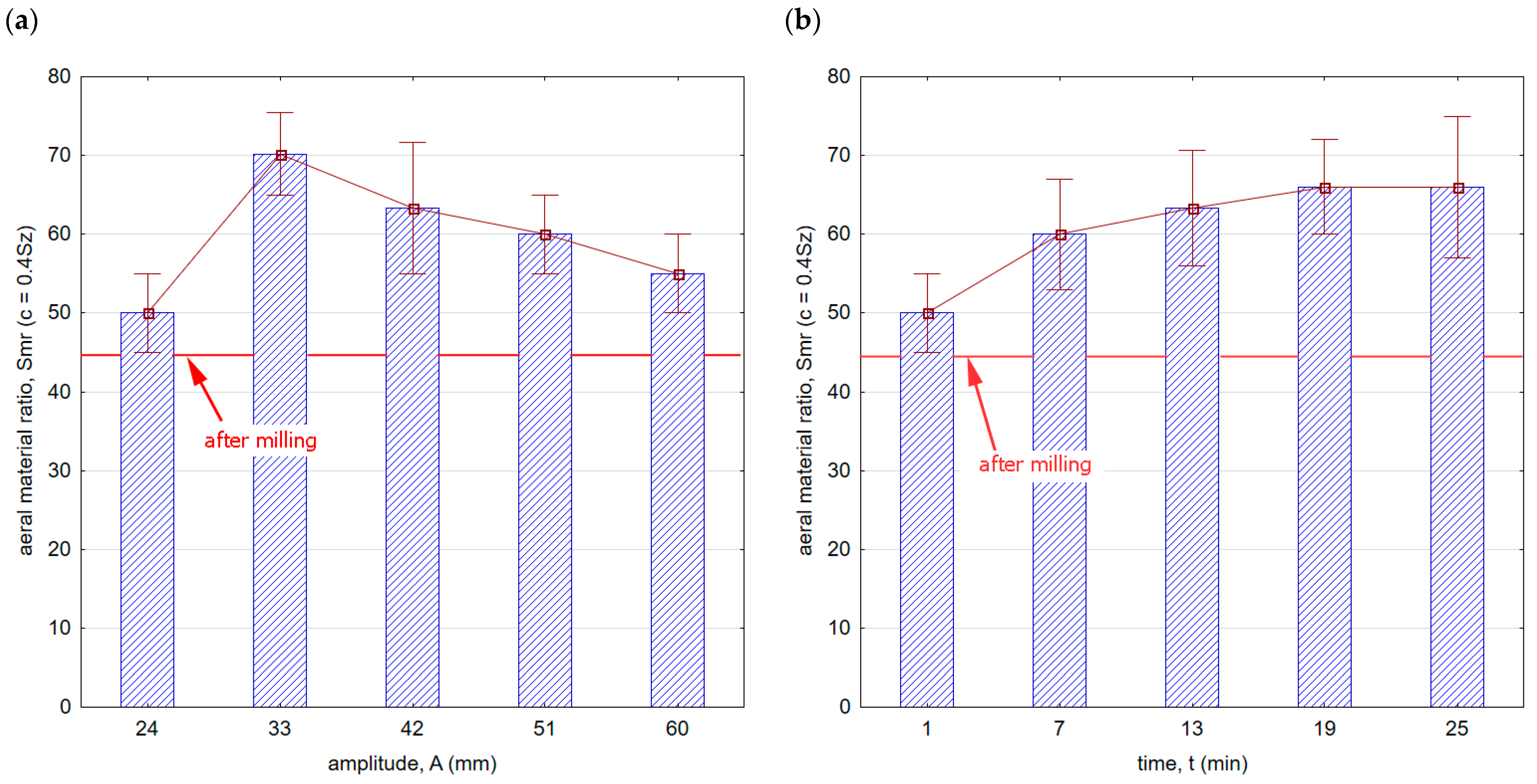
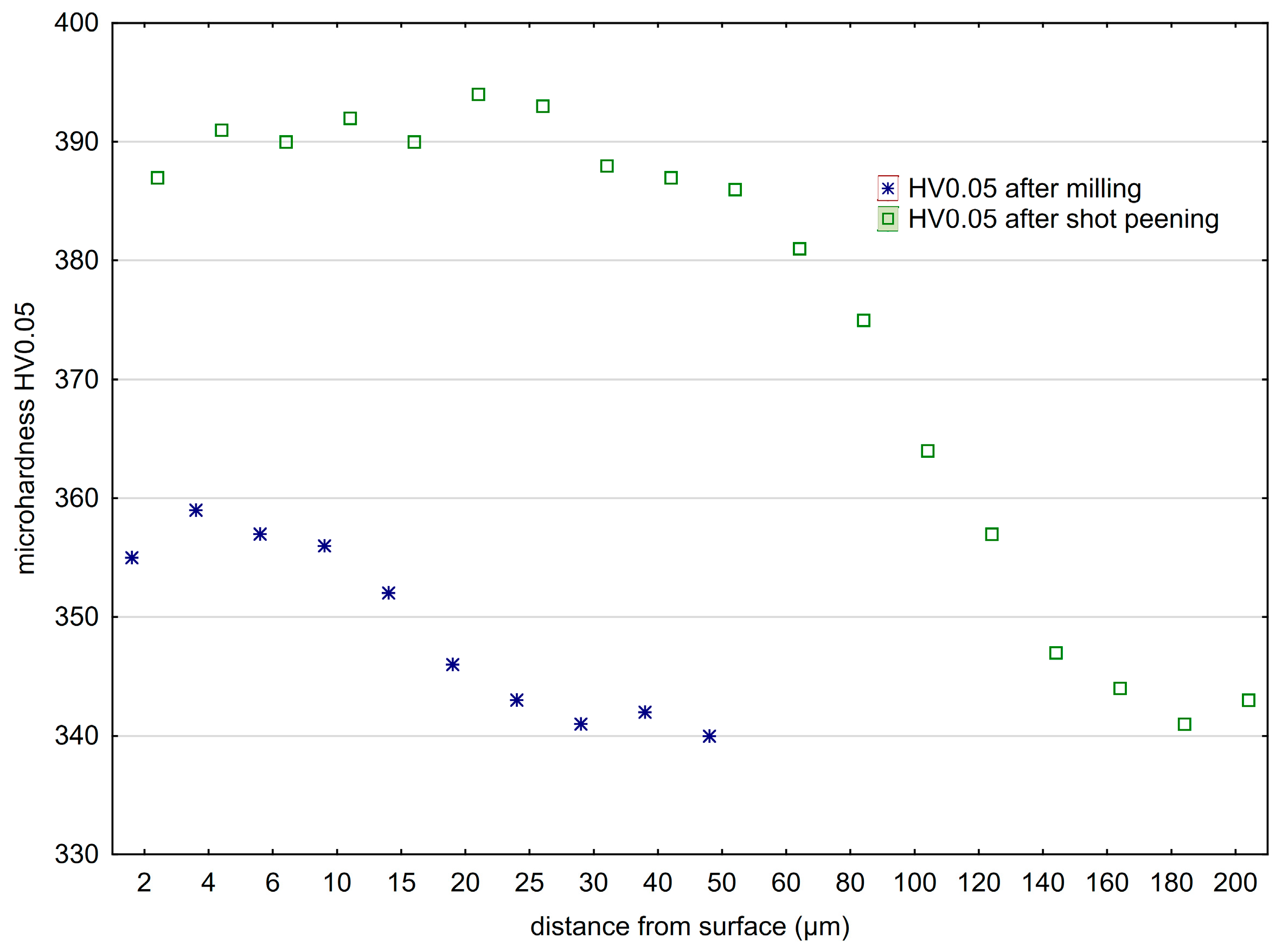

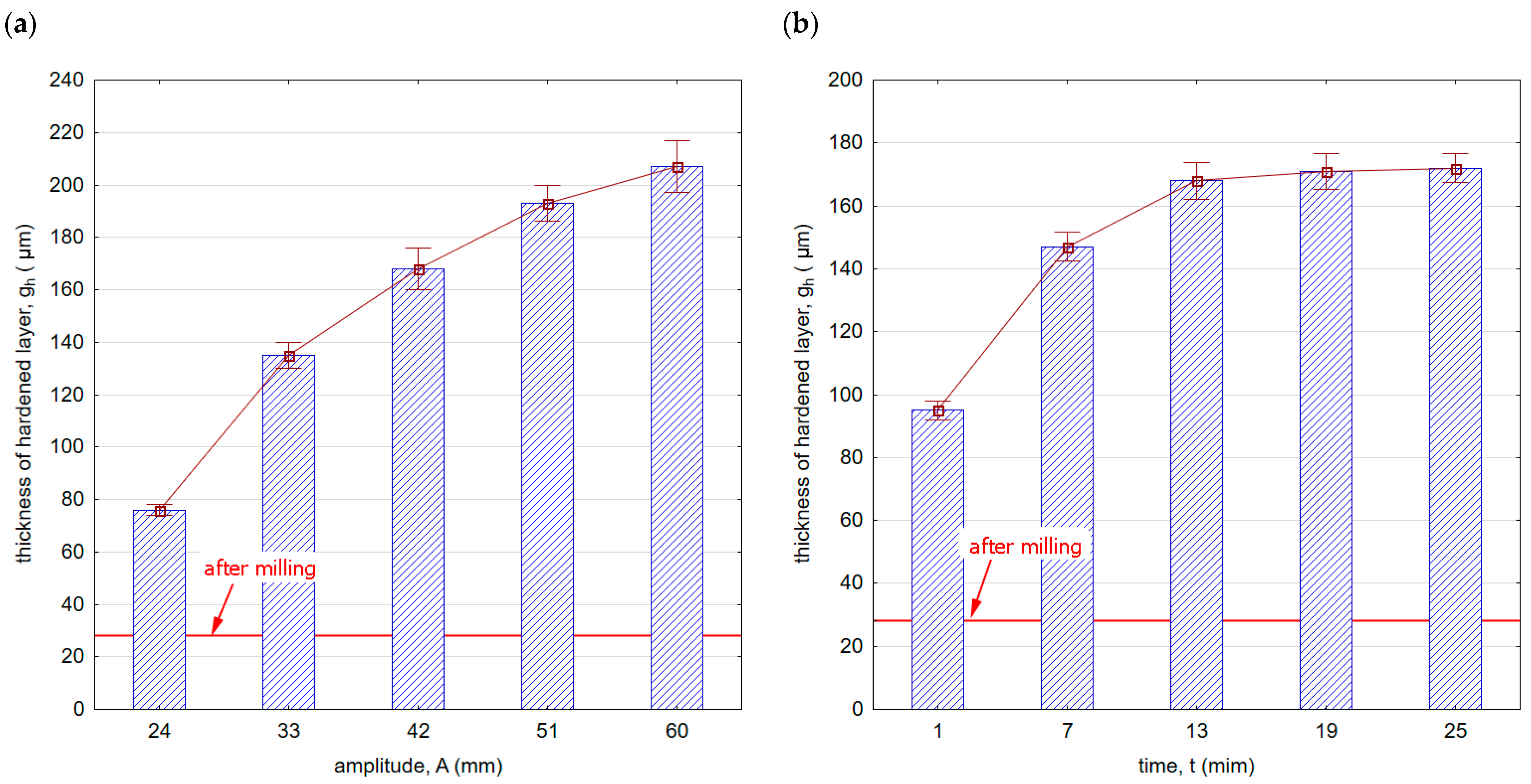
| Chemical Composition, Wt.% | Physical Properties | ||
|---|---|---|---|
| Al | 6.30 | Rm (MPa) | 1014 |
| V | 4.10 | ||
| C | 0.026 | E (GPa) | 120 |
| Fe | 0.20 | ||
| Ti | Rest | HRC | 33 |
| No. | Vibration Amplitude A (mm) | Vibration Time t (min) |
|---|---|---|
| 1 | 24 | 13 |
| 2 | 33 | |
| 3 | 42 | |
| 4 | 51 | |
| 5 | 60 | |
| 6 | 42 | 1 |
| 7 | 7 | |
| 8 | 19 | |
| 9 | 25 |
Disclaimer/Publisher’s Note: The statements, opinions and data contained in all publications are solely those of the individual author(s) and contributor(s) and not of MDPI and/or the editor(s). MDPI and/or the editor(s) disclaim responsibility for any injury to people or property resulting from any ideas, methods, instructions or products referred to in the content. |
© 2023 by the author. Licensee MDPI, Basel, Switzerland. This article is an open access article distributed under the terms and conditions of the Creative Commons Attribution (CC BY) license (https://creativecommons.org/licenses/by/4.0/).
Share and Cite
Matuszak, J. Analysis of Geometric Surface Structure and Surface Layer Microhardness of Ti6Al4V Titanium Alloy after Vibratory Shot Peening. Materials 2023, 16, 6983. https://doi.org/10.3390/ma16216983
Matuszak J. Analysis of Geometric Surface Structure and Surface Layer Microhardness of Ti6Al4V Titanium Alloy after Vibratory Shot Peening. Materials. 2023; 16(21):6983. https://doi.org/10.3390/ma16216983
Chicago/Turabian StyleMatuszak, Jakub. 2023. "Analysis of Geometric Surface Structure and Surface Layer Microhardness of Ti6Al4V Titanium Alloy after Vibratory Shot Peening" Materials 16, no. 21: 6983. https://doi.org/10.3390/ma16216983





